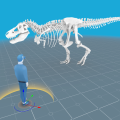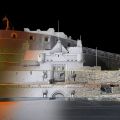30 OCTOBER
MORNING
9.00 h ACCREDITATION 9.30 h INSTITUTIONAL WELCOME
By Honorable Minister of Culture, Mariàngela Vilallonga and Marta Lacambra, Director of the Catalunya La Pedrera Foundation.
9.45 h The Cultural Logic of the Immersive. José Luis de Vicente, cultural researcher and exhibition curator specialising in culture, art and technology.

The adjective “immersive” has become widespread in all manner of cultural events and synonymous with so-called innovation. But what do we mean when we talk about the immersive? What can we learn within the field of the cultural heritage sector?
10.45 h Building Immersive Worlds for Heritage Audiences. Timothy Powell, Head of the Research and Development Studio at Historic Royal Palaces in London.

Heritage sites are engaged in the economy of experience, in which users expect their visit to be social, emotional, memorable and can be shared. Heritage managers must create experiences about not only what we want them to learn, but also what we want them to feel, as well as helping them to construct their own meanings based on our spaces and stories.
11.45 h COFFEE BREAK in Sala Gaudí
12.15 h Sketchfab: New Possibilities for Using Cultural and Historical 3D Content. Jeanne Lenglet, Business Development at Sketchfab.

The heritage sector has witnessed a boom in the production of historical and cultural 3D content because of the advent of 3D technology becoming increasingly more affordable and easy to use. As the question of how to digitise objects comes closer to being resolved, discussion has focused on the best way to use this collection of 3D models. Lenglet’s talk will present several cases for interactive 3D content to help guide organisations on their journey towards 3D in order to interact with existing audiences in new ways, etc.
13.15 h Working Digitally: Specific Applications for Cultural Heritage. Lyn Wilson, Digital Documentation Manager at Historic Environment Scotland.

Historic Environment Scotland is the public body that takes care of Scottish heritage. It has always been committed to innovative technologies and is currently digitally documenting the 336 heritage sites and thousands of objects of which it is custodian. This talk will show how to use digital data and technologies for monitoring and conservation, as well as for creating interactive learning resources, sharing 3D models or creating virtual reality apps or experiences.
14.15 h LUNCH BREAK in Sala Gaudí
AFTERNOON
3.45 pm SCREENING OF SELECTED VIDEOSFor this 4th Seminar, an open call was issued for videos on new narrative projects to be submitted. The best videos chosen by a panel of experts will be shown in this session.
4.00 pm NEW NARRATIVES AND THE CATALAN AGENCY OF CULTURAL HERITAGE
Damià Martínez, Catalan Agency of Cultural Heritage.
The presentation of some of the technological innovation and new narrative projects undertaken in the last three years in various museums, monuments and sites run by the Catalan Agency of Cultural Heritage.
4.15 pm THE DIGITAL STRATEGY OF THE ARCHAEOLOGY MUSEUM OF CATALONIA
Joan Muñoz, Archaeology Museum of Catalonia. Department of Culture.
Projects mounted by the Archaeology Museum of Catalonia incorporate the use of ICT as a means to create value from the outset. This has led to the production of resources associated with immersive and augmented reality experiences, headsets with immersive videos of sites in 360 degrees, a large video mural and a 3D site simulator. As a result, we have particularly extensive archaeological collections in 3D and a selection of e-books.
4.30 pm CULTURAL HERITAGE IN CATALONIA IN 3D AND THE HERITAGE DIGITISATION PROGRAMME
Albert Sierra, Catalan Agency of Cultural Heritage, and Lluís González, Directorate-General of Cultural Heritage. Department of Culture.
Catalan heritage in 3D is establishing an increasingly important presence on the internet. This project aims to boost that and to lay the foundations for work in partnership with the entire sector through digitisation initiatives, workshops and the use of standards.
4.50 pm THE 3D VIRTUAL TOURS OF HALLWYL HOUSE IN STOCKHOLM AND THE COMMUNITY RESPONSE
Erik Lesternal. National Historical Museums photographer. Sweden.
Hallwyl House was one of the most impressive residences built in the 19th century in Sweden. Its many staircases make physical access difficult, which led to the launch in 2017 of a digital accessibility project, with the interiors displayed in 3D. This project went much further than could possibly have been imagined at the outset.
5.05 pm GDH: A 3D PROJECT FOR THE WORLD
Víctor López Menchero. Scientific Director, Spain, Global Digital Heritage.
Global Digital Heritage is a not-for-profit organisation dedicated to documenting, monitoring and preserving our cultural and natural heritage. It uses digital visualisation, 3D virtualisation, geospatial informatics and open access solutions to provide 3D models and digital data to governments and institutions. It makes all its work freely available in order to support research and education and as an expression of its commitment to the democratisation of science.
5.20 pm NEW NARRATIVES AT THE WATER MUSEUM
Sònia Hernández. Director.
The Water Museum has always sought new ways to reach out to audiences, especially young people, in order to share knowledge to do with water and the environmental and cultural values surrounding it. Online comics, apps and escape rooms are just some of the strategies it has employed.
5.40 pm IDEAL: THE FIRST DIGITAL ARTS CENTRE
Jordi Sellas. Executive Director.
IDEAL (Immersive, Digital, Exhibitions, Arts, Lab) is Spain’s first digital arts centre. With 2,000 m2 given over to digital culture creation, training and dissemination, it will have an immersive exhibition room, a Dome, technological creative labs and a virtual reality area. It is launching with an experience about Monet, but its aim is to create new projects, including initiatives focusing on the country’s heritage.
5.55 pm PEDRALBES MONASTERY THROUGH A VIDEO GAME OF VIRTUAL REALITY AND SERIOUS GAME
Anna Castellano, Director of Pedralbes Monastery Museum, and Albert Burzon, Creative Director and Manager of Burzon*Comenge.
After a long development, with a large and ambitious research, we are now able to immerse ourselves in the private spaces of this female monastery from its beginnings to the present. The digital reconstruction of the whole monastery is the basis of a virtual recreation with 3D technology of the 15th century spaces, with a clear pedagogical and playful goal.
CONCLUSIONS
6.20 pm DIGITAL HERITAGE
Marisol López. Director of the Digital Culture Division. Catalan Institute of Cultural Industries. Department of Culture.

